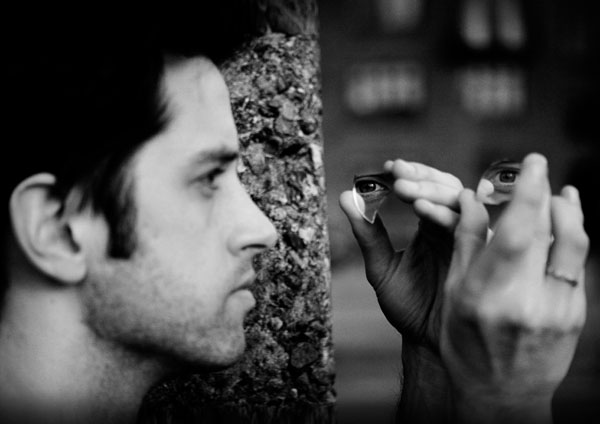Worlds collide with Steen-Andersen’s visuals overwhelming his rigid music
Danish composer and performer Simon Steen-Andersen opened the Miller Theatre season Thursday night with a conceptual, multimedia spectacle titled “Run Time Error.”
In DJ-like fashion, Steen-Andersen manipulated prerecorded sound and video, and was joined by JACK Quartet, who were integral to the piece. JACK is one of the finest string quartets of the day, and among their notable qualities is the power and energy they wield. It was a surprise, then, to see them almost subsumed by Steen-Andersen’s technological tools. He used them like a DJ, manipulating speed and direction, and although a substantial part of the evening was a notable success, much of it turned out to be a demonstration of technology as a toy for grown-ups.
There was a disconnect between goals and realization, and Steen-Andersen’s work often seemed at odds with itself. The title was misleading and a little frustrating. “Run Time Error” promises some sort of exploration of how automatic processes go wrong, a fascinating topic. But the only glitch was the opening, with the prerecorded announcement asking patrons to silence their cell phones turning into a stutter. This segued into Run Time Error, version one.
Run Time Error is an amazing two channel video that showed Steen-Andersen winding his way through Miller, upstairs, downstairs, backstage, in the seats, everywhere. Carrying a microphone with him, he used the theater itself as a giant percussion instrument, and played and triggered myriad Rube Goldberg percussion machines along the way. He also kept passing by the members of JACK, who played long tones and fragments, looking comparatively like straight men in a Buster Keaton movie.
Steen-Andersen controlled the video from the stage with a joystick in each hand. With these, he could vary the speed and direction of each channel, use one to echo the other, run things in reverse and loop them. The entire video was intricately choreographed, yet always seemed spontaneous, as if Steen-Andersen opened that particular door at random and it just so happened that violinist Christopher Otto and Ari Streisfeld, or violist John Pickford Richards, happened to be standing there; or else a ball just happened to drop into a long trough hung from the ceiling, or a roll of masking tape conveniently got caught on his percussion stick so he could unravel it while walking along. Good thing he had his microphone to capture all the sounds. The video was incredibly entertaining, and the way Steen-Andersen presented it was artful and satisfying.
But when the performance focused more on his music, along came the problems. One was that the video—a second version of it ended the evening, which was played contiguously—set an ambitiously high bar. The other was that, although the techniques Steen-Andersen used for the rest of the performance were inventive, his music and conceptual thinking were not.
Steen-Andersen’s mastery of technology is impressive. The penultimate piece, Study for String Instrument No. 3, had cellist Kevin McFarland playing solo with the projected image of himself laid over him. Steen-Andersen again controlled the projection so that it seemed McFarland had two right arms, one echoing the other visually and sonically, in a duo (and at moments, trio) with himself. It was amazing to see.
JACK played pieces like Study for String Instruments No. 1 and String Quartet No. 2, interspersed with more video of three different Obstruction Studies. Those consisted of the quartet playing different movements of Schumann’s A Major Quartet, Op. 41, No. 3, while hampered by rubber bands and weights in the first, the combination of white noise and darkness in the second, and the use of what Steen-Andersen calls the prepared bow in the third. The bow is prepared with masking tape around some of the hairs, or materials attached to the wood, and produces sharp-edged, scratchy, pitches.
The Obstruction Studies are interesting essays in Dada with irreverence toward the classics. But the other pieces, for all their interesting visuals and use of preparation and electronic signal processing, were rudimentary, exercises with little compositional process or point.
They are also tyrannically rigid, and this was a fundamental problem. The Spike Jones-like anarchy of the video and the retrograde order of the music JACK played were meant as complementary. Steen-Andersen seems to be making an argument about how technology can rework musical processes, but he’s using technology as a means of control that stifles his own attempted results. These truly opposite forces and values collided, and in terms of the basic pleasure of the experience, the videos annihilated the music. At least with the second version of Run Time Error, good triumphed in the end.
